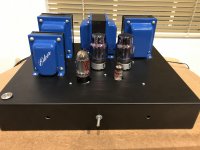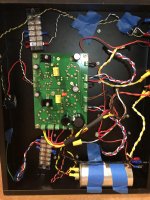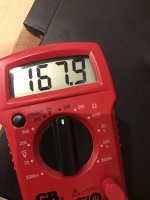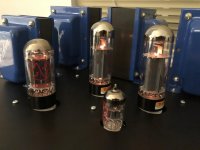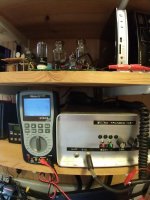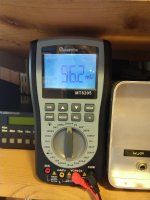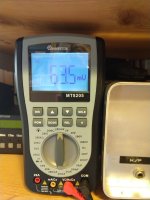Ran into an issue that I can't seem to troubleshoot on my own.
Amp was up running on the breadboard and sounded great, after I put it into my enclosure, after a few minutes of running the audio on one channel dies out. It's consistently the same channel, even after swapping the tubes. If I power it down for an hour or so the audio will play on both channels, but after a few minutes goes back to one channel.
I've also noticed that the louder the volume, the faster the channel dies out.
Any thoughts on how to identify/fix the issue?
Thanks!
Amp was up running on the breadboard and sounded great, after I put it into my enclosure, after a few minutes of running the audio on one channel dies out. It's consistently the same channel, even after swapping the tubes. If I power it down for an hour or so the audio will play on both channels, but after a few minutes goes back to one channel.
I've also noticed that the louder the volume, the faster the channel dies out.
Any thoughts on how to identify/fix the issue?
Thanks!
Attachments
Attachments
You are running KT-88's, so that will put more thermal stress on the cathode bias resistors than lower power tubes.
A sort of wild guess is that there might not be enough air circulation around your cathode bias resistors for the power tubes, since they appear to be between the board and your chassis.
Another related sort of wild guess is that, since stuff expands when it is hot, maybe you have a solder connection on those bias resistors that gets sketchy as things heat up.
Win W5JAG
A sort of wild guess is that there might not be enough air circulation around your cathode bias resistors for the power tubes, since they appear to be between the board and your chassis.
Another related sort of wild guess is that, since stuff expands when it is hot, maybe you have a solder connection on those bias resistors that gets sketchy as things heat up.
Win W5JAG
Maybe a 10M45 chip is getting too hot!
I doubt that a fried or overheated 10M45 alone could put voltage on the input jack. Semiconductors usually fail to a short circuit. The SSE will play with the 10M45 totally shorted, although the gain will be low and the 12AT7 could overheat.
It might be possible that the 10M45 is bad, installed backwards, or counterfeit. There have been counterfeit 10M45's sold on Ebay and through other sources. Most have been reported in Europe.
A shorted 10M45 will cause the 12AT7 to draw too much current, overheat, and possibly fail. Still, it would take a really bad or gassy tube to have enough grid current to "leak" 164 volts on to its grid. Does one half of the tube glow much brighter than the other half? It its plate glowing, or it there some blue or purple glow around or inside it's plate? Compare the voltages on the 12AT7 plates to each other when it's working, then again after it starts to fade.
At first I thought that there had to be a serious wiring error, but you say the amp plays for a while. Unplug the 12AT7, turn on the amp. Is the voltage still there?
Measured the input cable with my multimeter, and it read 164 volts, any idea how I have a dc current going through input jacks?
I don't see how it is possible to get + 164 volts on the input unless there is a plate to grid short in the tube.
Measurement error seems the more likely possibility to me.
Its happened that folks get the decimal points messed up on their voltmeter readings, and also try to read DC on the AC scale, and vice versa, or combinations of all this. Not saying you have done this, but it is worth thinking about and eliminating.
- 1.64 DC volts between the grid and cathode would be about right, maybe a little low, but your input pot may have divided it down some, or the bias resistor is skewing it if you are referencing to ground potential?
Win W5JAG
Last edited:
I don't see how it is possible to get + 164 volts on the input unless there is a plate to grid short in the tube.
Measurement error seems the more likely possibility to me.
Quite possible, I am a new at this. Here is a pic of the multimeter.
Does one half of the tube glow much brighter than the other half? It its plate glowing, or it there some blue or purple glow around or inside it's plate?
No I don't see anything off with the tube. took a pic of the tubes with the amp running.
At first I thought that there had to be a serious wiring error, but you say the amp plays for a while. Unplug the 12AT7, turn on the amp. Is the voltage still there?
Voltage goes away with 12AT7 removed.
Attachments
IF poor ventilation is the fault, which remains to be determined, just move the cathode bias resistors to the other side of the board, and space them 3/8 inch or so off the board to allow air to move around them ...
Win W5JAG
Done, still fades on the same channel.
The sine wave means AC setting. The DC settings are on the left.
Can you show us where you have the probes attached to obtain this reading?
Learn something new every day.
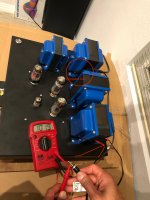
OK ... well ... something is amiss here ...
First, massive hum when an input cable is disconnected from a source, but still attached to the SSE is not abnormal. I would say it is to be expected and normal.
As to the voltage you are measuring, George probably needs to weigh in on this ...
I hooked up a DMM to the inputs on one of my SSE - first pic shows ( hopefully ) the attachment. It's done through clip leads, but this is the equivalent of hooking the positive probe to the circuit board positive input of one channel, and the negative lead to the corresponding negative circuit board input of the same channel.
If you can see the graphic display on the DMM, it's just showing the AC residual from the power lines in the shack, and being randomly picked up on the clip leads.
The other pics are the AC and DC voltages the DMM is measuring. The AC is just the random stuff floating around as aforesaid. Both are in the millivolt range.
It might be informative for you to completely disconnect the bad channel input leads from the printed circuit board, and measure the AC and DC voltages at these terminals with nothing else attached to them. That way we can isolate the problem as either internal or external to the PCB.
Win W5JAG
First, massive hum when an input cable is disconnected from a source, but still attached to the SSE is not abnormal. I would say it is to be expected and normal.
As to the voltage you are measuring, George probably needs to weigh in on this ...
I hooked up a DMM to the inputs on one of my SSE - first pic shows ( hopefully ) the attachment. It's done through clip leads, but this is the equivalent of hooking the positive probe to the circuit board positive input of one channel, and the negative lead to the corresponding negative circuit board input of the same channel.
If you can see the graphic display on the DMM, it's just showing the AC residual from the power lines in the shack, and being randomly picked up on the clip leads.
The other pics are the AC and DC voltages the DMM is measuring. The AC is just the random stuff floating around as aforesaid. Both are in the millivolt range.
It might be informative for you to completely disconnect the bad channel input leads from the printed circuit board, and measure the AC and DC voltages at these terminals with nothing else attached to them. That way we can isolate the problem as either internal or external to the PCB.
Win W5JAG
Attachments
Ghan-Measurement error seems the more likely possibility to me.
Are you sure your meter is working properly? (Test voltage section with dry cell and AC outlet measurements....?)
How fresh is the battery in your meter?
Do you have another meter?
So a few things,
Audio no longer fades from the channel! I've played for an hour or so with both kt88 and el34's and different volume levels. Sounds incredible!
If there is nothing connected to the input cable, and the the volume knob is anything above minimum, there is an EXTREMELY high pitched noise that is emitted from my speakers. It's not loud, just very high pitched.
If I disconnect the input cable from my audio source while the amp is on the speakers emit a loud pulsing shrill noise. Noise immediately goes away when I plug it back into the source, or if I turn the volume all the way down.
Switched over to DC mode 200 scale, reading is zero. But when I drag the multimeter lead across the audio input cable tip, the numbers spike 100+ then immediately go away. Not so scientifically, I also touched the tip of the input cable (not sure if this was a smart decision), and depending on which part of the input tip I touched I could feel a current flow/shock.
Can take a video/record audio if that would be helpful.
Appreciate all of the help!
Audio no longer fades from the channel! I've played for an hour or so with both kt88 and el34's and different volume levels. Sounds incredible!
If there is nothing connected to the input cable, and the the volume knob is anything above minimum, there is an EXTREMELY high pitched noise that is emitted from my speakers. It's not loud, just very high pitched.
If I disconnect the input cable from my audio source while the amp is on the speakers emit a loud pulsing shrill noise. Noise immediately goes away when I plug it back into the source, or if I turn the volume all the way down.
Switched over to DC mode 200 scale, reading is zero. But when I drag the multimeter lead across the audio input cable tip, the numbers spike 100+ then immediately go away. Not so scientifically, I also touched the tip of the input cable (not sure if this was a smart decision), and depending on which part of the input tip I touched I could feel a current flow/shock.
Can take a video/record audio if that would be helpful.
Appreciate all of the help!
Switched over to DC mode 200 scale, reading is zero. But when I drag the multimeter lead across the audio input cable tip, the numbers spike 100+ then immediately go away. Not so scientifically, I also touched the tip of the input cable (not sure if this was a smart decision), and depending on which part of the input tip I touched I could feel a current flow/shock.
Those aren't good signs! I do think you have a problem there - oscillation and ???
Sometimes an old 'needle' analog meter is better for troubleshooting vs. watching different numbers flickering on the display of a digital multimeter.
First step I'd do would be to stop using any good sources with this amp...time to pull out that thrift store $10 CD/DVD player. Also, use your 'shop speakers' not your good ones.
Next- make shorting plugs for the RCA input jacks - take an old RCA interconnect cable and make separate shorting plugs for each channel. (Cut off a few inches of the cable with the plug still attached, strip the insulation and twist and solder together the center conductor with the shield.)
Even some 'OK' amps will 'act up' sometimes if you leave a cable (antenna) plugged in and hanging...but still not good.
Audible high pitched shrill, measured AC voltage, and it bit your finger - it's definitely oscillating. Which it should not do - the amp should be unconditionally stable.
Do you have any other 12AT7's you can try?
A number of possible solutions: best is to redo your chassis wiring to break the positive feedback loop, wherever it is. My guess is that the grounding is poor.
It's a risky proposition to not sort this out, even if the amp seems okay when you have something plugged into it, because, if it takes off, or is still oscillating at some frequency you can't hear, the AC oscillator voltage produced could get rectified in your source and produce a large DC voltage. Most solid state parts fry when a large AC or DC voltage is applied to them.
Win W5JAG
Do you have any other 12AT7's you can try?
A number of possible solutions: best is to redo your chassis wiring to break the positive feedback loop, wherever it is. My guess is that the grounding is poor.
It's a risky proposition to not sort this out, even if the amp seems okay when you have something plugged into it, because, if it takes off, or is still oscillating at some frequency you can't hear, the AC oscillator voltage produced could get rectified in your source and produce a large DC voltage. Most solid state parts fry when a large AC or DC voltage is applied to them.
Win W5JAG
- Status
- This old topic is closed. If you want to reopen this topic, contact a moderator using the "Report Post" button.
- Home
- More Vendors...
- Tubelab
- 1 channel fades after a few minutes of playing - SSE
